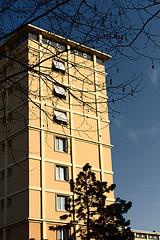 Ventilated facades: Key Elements of Designs For additional warming of outdoor structures between the wall and cladding can be installed insulating layer – in this case, in this case ventilation gap is left between the lining and insulation. In the ventilated facade design individual layers are as follows: wall insulation, air gap, the protective screen. Such a scheme is optimal, because layers of different materials are arranged with decreasing indices of their heat, and resistance to water vapor permeability increases from outside to inside. 1. Bearing wall A wall is a fulcrum for system. At the device mounted facade, are essential parameters such as: deviations from the walls vertically and horizontally, "littered" corners that are detected by the method of surveying.
Ventilated facades: Key Elements of Designs For additional warming of outdoor structures between the wall and cladding can be installed insulating layer – in this case, in this case ventilation gap is left between the lining and insulation. In the ventilated facade design individual layers are as follows: wall insulation, air gap, the protective screen. Such a scheme is optimal, because layers of different materials are arranged with decreasing indices of their heat, and resistance to water vapor permeability increases from outside to inside. 1. Bearing wall A wall is a fulcrum for system. At the device mounted facade, are essential parameters such as: deviations from the walls vertically and horizontally, "littered" corners that are detected by the method of surveying.
Also of considerable importance is the material of which it is built and its degree of wear (if you have any). 2. substructure construction consists of brackets that attach directly to the wall, and bearing profiles forming the skeletal system, with special fastener elements mounted plate (sheet) tiles. The main purpose of designs is to securely attach a plate coating and insulation to the wall so that the insulation between the panel was finishing the ventilation gap. This excludes adhesives and other "wet" processes, and all connections are made mechanically. 3. Heat and sound insulation layer itself insulating layer protects the wall by alternating freezing and thawing, thus equalizes the temperature fluctuations in the wall and prevents deformation, especially adversely affecting the high-rise buildings. Thermal insulation has other advantages – increases the heat storage capacity of the wall and increases the sound insulation in a wide range of frequencies more than twice.